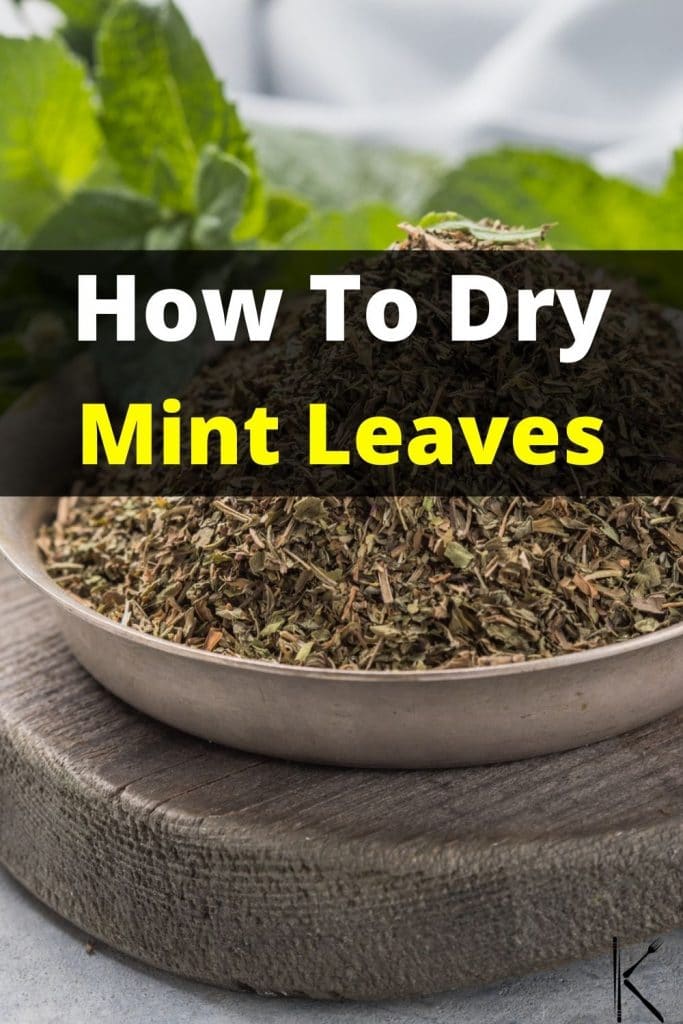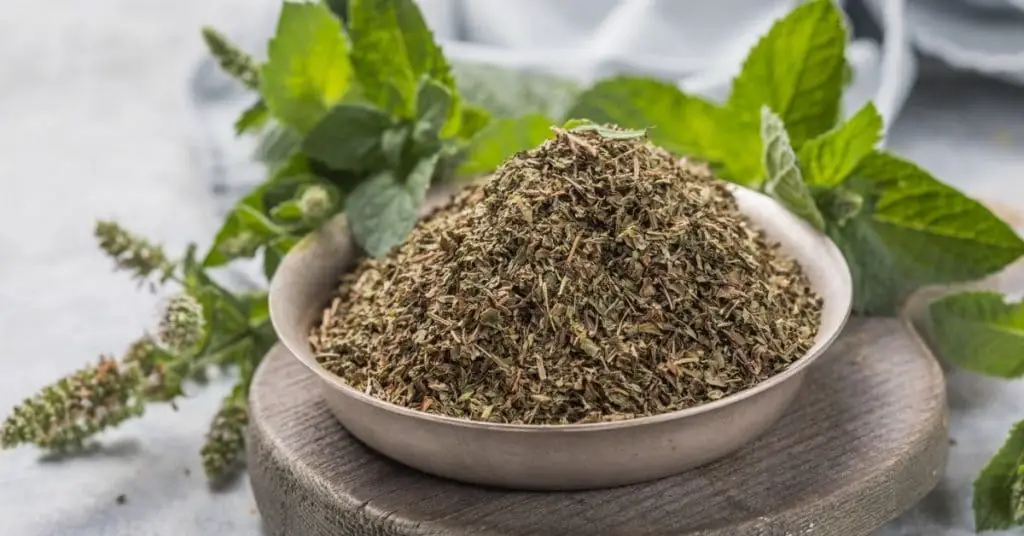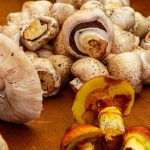In short, there are two methods to dry mint leaves: air-drying by hanging them in bundles or oven-drying by baking them at a low temperature.
Mint plants flourish in the right conditions and spread quickly. If you have a herb garden, growing your own mint is a must. You can make fresh mint tea, flavor drinks, add it to salads, and so much more. However, since mint grows well, you can easily end up with way more mint leaves than you can use.
Luckily, you can dry mint to extend its shelf life. This means that a good mint harvest can add flavor to your cooking for over a year long.
While making your own dried mint is pretty simple, there are a few important things that will affect the quality. Here’s what you need to know to dry fresh mint leaves successfully.
Can You Dry Mint Leaves?
Yes, there are several ways to dry mint leaves. For the best flavor preservation, dry mint naturally by air drying/hanging. Using heat drying methods such as the oven or dehydrator methods are quicker and best if you live in a humid climate. The microwave method is super quick, but it can damage the mint essential oils and dull the flavor.
As we just mentioned, the climate will play a role in the method you choose as high humidity can compromise the drying of your herbs.
When drying mint, it is important to make sure that the herbs are completely dry before packing. Mold will develop if excess moisture is present, even inside airtight containers.
How To Dry Mint
Preparation: Cleaning
Lightly rinse the leaves in cold water. This will remove dirt, chemicals, and small insects. Don’t let the leaves spend too much time in the water. Place the mint leaves on a clean kitchen towel or paper towels and pat dry. Alternatively, you can also use a salad spinner.
Removing excess water is imperative to successfully drying the herbs. Do not start the drying process if the leaves are still moist from washing. Let them dry in the open air for 30 minutes if necessary. Discard any damaged, moldy, or wilted leaves.
Follow the instructions below for oven-drying or air-drying mint according to the dehydrating process you prefer.
Option 1: Air Drying Mint
Step 1: Tie Bundles
Tie a few mint sprigs together with a twist tie, rubber band, or string to form small bunches.
Step 2: Hang
Choose a place with good light and air circulation and hang the herb bundles to dry. The leaves should be facing downwards.
Avoid areas that are moist such as spaces near a stove, dishwasher, or bathroom. Do not hang the mint in direct sun.
To protect the herbs from dust, cover each bundle with a perforated paper bag or muslin cloth. Punch holes in the bag and leave the bottom open to allow for sufficient air flow.
Do not use plastic as this will prevent airflow and cause moldy mint.
Depending on the climate, the mint will take 1 to 2 weeks to dry. The leaves should be brittle and break easily when you handle them. Leaves that are still somewhat pliable and do not crumble are not yet sufficiently dried.
Tip: Instead of drying herbs by hanging you can also lay them out on a herb drying rack in a well-ventilated area.
Step 3: Store
Take the dried herb bundles down and carefully remove the brown bag. Small, crushed pieces are best for cooking, however, you can store the leaves whole if you are using them for tea.
Working over a bowl, remove the leaves from the stems. Crumble the dried leaves into small pieces.
Store dried mint in a glass jar or airtight container. Label it with the date and contents.
Option 2: Oven-Drying Method
Step 1: Preheat Oven
Preheat the oven to its lowest temperature setting between 140 °F to 180 °F (60 °C to 82 °C).
Tip: If your oven does not have such a low setting, prop the oven door open just slightly.
Step 2: Prepare Leaves
Remove mint leaves from the stem. Place the cleaned mint leaves on a baking sheet lined with parchment paper. Spread the mint out in a single layer. Don’t let the leaves overlap each other.
Step 3: Bake
Once the oven has heated to temperature, place the cookie sheet inside the oven and switch the oven off. This prevents the leaves from overheating and losing their flavor. Check on the leaves after 10 minutes.
If they have not yet sufficiently dried, leave them in the oven to continue drying, checking every 5 minutes. The leaves should curl and crumble when pinched between your fingers.
Step 4: Store
Let the dried mint leaves cool for a few minutes and then crush the dried leaves over a bowl or plate. You can also give them a quick whizz in a food processor.
Store the mint in resealable plastic bags, spice bottles, or airtight containers. Label with the date and contents.
Once dried and packaged, store the mint in a cool, dry, and dark place away from direct sunlight.
Types of Mint
While there are many types of mint plant varieties, there are a few specific species that are popular for home gardeners.
Peppermint
Peppermint is the most well-known type of mint to grow. The mint leaves are bright green and highly fragrant. The leaves grow in opposite pairs on the mint stems.
Spearmint
Spearmint is a milder type of mint than peppermint. It is a popular flavor in candies, gum, and teas. The green mint leaves are spear-shaped and quite easily differentiated from other types of mint.
Apple Mint
Apple mint, or pineapple mint, also makes a great culinary herb. It has a rich, fruity flavor, and is perfect in a glass of cold iced tea or added to fruit salad.
Chocolate Mint
Chocolate mint has a slight chocolatey undertone beneath the mint flavor. It is not quite as strong as peppermint, but makes for an interesting addition to your cooking.
Regardless of the type, mint leaves have a pleasantly refreshing and very recognizable smell with a slightly sweet flavor and cooling aftertaste.
The herb is very versatile. It is used in sweet and savory dishes as well as mint tea, cocktail beverages, and syrup. Whether you are making a salad dressing, lamb dish, ice cream, or fruit salad, it is a great herb to have in stock at all times.
FAQs
Conclusion: Main Ways of Drying Mint
With several varieties to choose from, growing your own mint at home is fun and easy. With a great flavor, aroma, and health benefits, mint is a popular herb in sweet and savory cooking. If you grow mint at home, the best time for harvesting is late spring, just before the plant flowers. Alternatively, get a stash from a farmers market and carefully dry the mint yourself. You can also use these methods for drying other herbs.
When it comes to drying mint leaves, low and slow is best. Use a low temperature for a little longer rather than trying to dry it quickly at high heat. You will thank yourself later for the well-preserved flavor.
Take care to dry and store your herbs away from moisture and out of direct sunlight. With your stash of dried herbs handy year-round, use the dried mint to make delicious sauces, dressings, marinades, cocktails, and desserts. Simply steep your tea leaves in hot water and add honey and lemon if desired for a soothing cup of mint tea.
See more guides and learn how to dry sage, thyme, cilantro, basil and parsley.

*image by sokor/depositphotos









